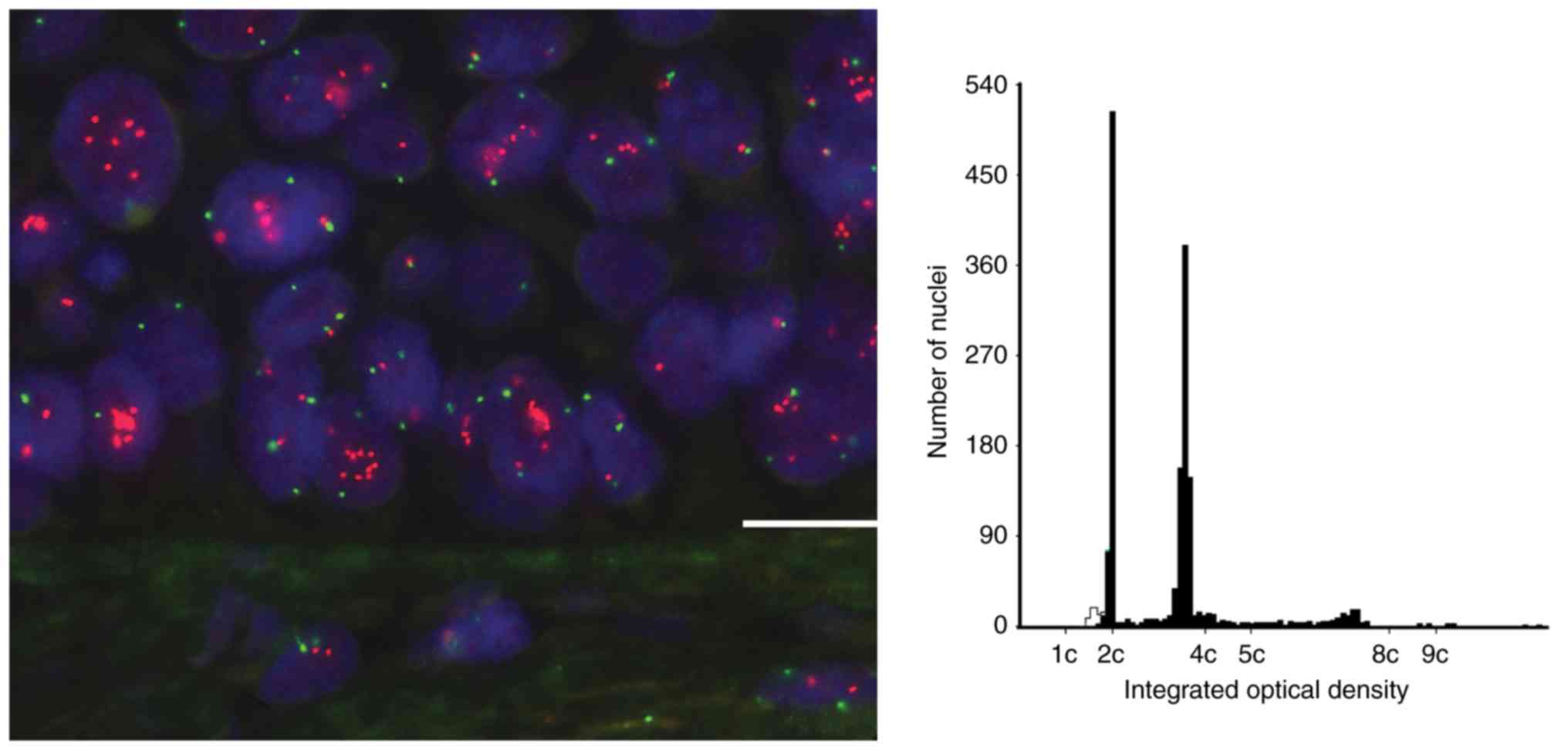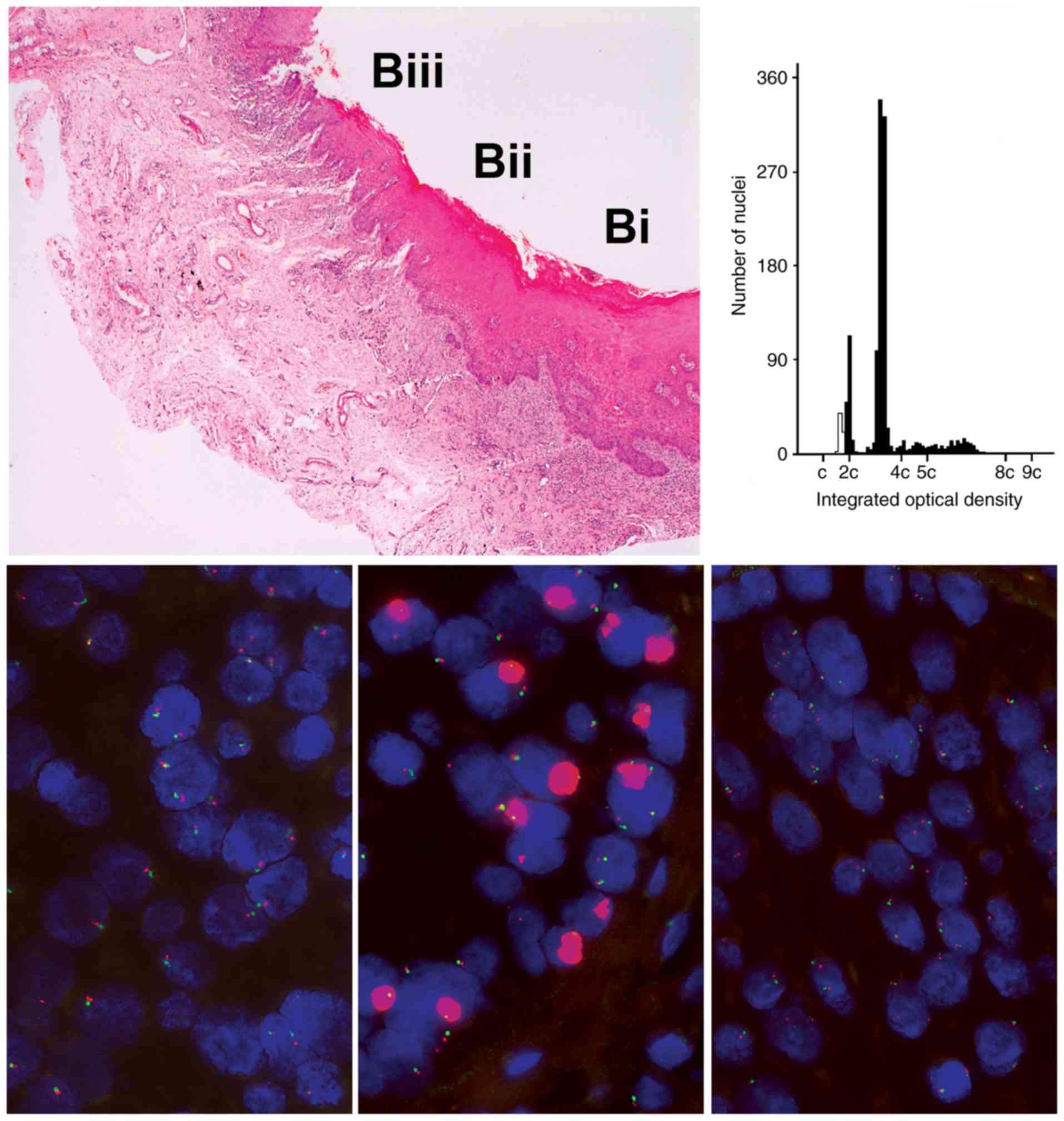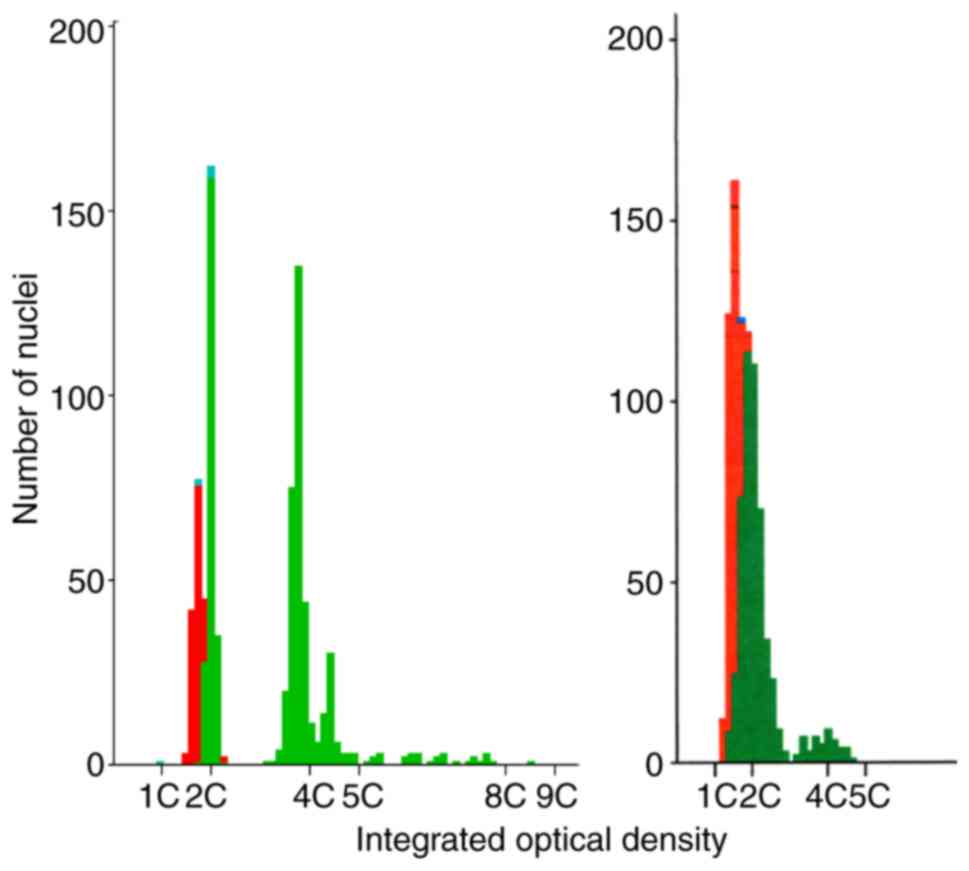|
1
|
Woolgar JA: Histopathological
prognosticators in oral and oropharyngeal squamous cell carcinoma.
Oral Oncol. 42:229–239. 2006. View Article : Google Scholar : PubMed/NCBI
|
|
2
|
Massano J, Regateiro FS, Januário G and
Ferreira A: Oral squamous cell carcinoma: Review of prognostic and
predictive factors. Oral Surg Oral Med Oral Pathol Oral Radiol
Endod. 102:67–76. 2006. View Article : Google Scholar : PubMed/NCBI
|
|
3
|
Warnakulasuriya S, Johnson NW and van der
Waal I: Nomenclature and classification of potentially malignant
disorders of the oral mucosa. J Oral Pathol Med. 36:575–580. 2007.
View Article : Google Scholar : PubMed/NCBI
|
|
4
|
Holmstrup P, Vedtofte P, Reibel J and
Stoltze K: Long-term treatment outcome of oral premalignant
lesions. Oral Oncol. 42:461–474. 2006. View Article : Google Scholar : PubMed/NCBI
|
|
5
|
Dost F, Lê Cao K, Ford PJ, Ades C and
Farah CS: Malignant transformation of oral epithelial dysplasia: A
real-world evaluation of histopathologic grading. Oral Surg Oral
Med Oral Pathol Oral Radiol. 117:343–352. 2014. View Article : Google Scholar : PubMed/NCBI
|
|
6
|
Brouns E, Baart J, Karagozoglu Kh, Aartman
I, Bloemena E and van der Waal I: Malignant transformation of oral
leukoplakia in a well-defined cohort of 144 patients. Oral Dis.
20:e19–e24. 2014. View Article : Google Scholar : PubMed/NCBI
|
|
7
|
Gupta PC, Mehta FS, Daftary DK, Pindborg
JJ, Bhonsle RB, Jalnawalla PN, Sinor PN, Pitkar VK, Murti PR, Irani
RR, et al: Incidence rates of oral cancer and natural history of
oral precancerous lesions in a 10-year follow-up study of Indian
villagers. Community Dent Oral Epidemiol. 8:283–333. 1980.
View Article : Google Scholar : PubMed/NCBI
|
|
8
|
Mincer HH, Coleman SA and Hopkins KP:
Observations on the clinical characteristics of oral lesions
showing histologic epithelial dysplasia. Oral Surg Oral Med Oral
Pathol. 33:389–399. 1972. View Article : Google Scholar : PubMed/NCBI
|
|
9
|
Bánóczy J and Sugár L: Longitudinal
studies in oral leukoplakias. J Oral Pathol. 1:265–272. 1972.
View Article : Google Scholar : PubMed/NCBI
|
|
10
|
Silverman S Jr, Gorsky M and Lozada F:
Oral leukoplakia and malignant transformation. A follow-up study of
257 patients. Cancer. 53:563–568. 1984. View Article : Google Scholar : PubMed/NCBI
|
|
11
|
Schepman KP, van der Meij EH, Smeele LE
and van der Waal I: Malignant transformation of oral leukoplakia: A
follow-up study of a hospital-based population of 166 patients with
oral leukoplakia from The Netherlands. Oral Oncol. 34:270–275.
1998. View Article : Google Scholar : PubMed/NCBI
|
|
12
|
Sperandio M, Brown AL, Lock C, Morgan PR,
Coupland VH, Madden PB, Warnakulasuriya S, Møller H and Odell EW:
Predictive value of dysplasia grading and DNA ploidy in malignant
transformation of oral potentially malignant disorders. Cancer Prev
Res (Phila). 6:822–831. 2013. View Article : Google Scholar : PubMed/NCBI
|
|
13
|
Zaini ZM, McParland H, Møller H, Husband K
and Odell EW: Predicting malignant progression in clinically
high-risk lesions by DNA ploidy analysis and dysplasia grading. Sci
Rep. 8:158742018. View Article : Google Scholar : PubMed/NCBI
|
|
14
|
Bradley G, Odell EW, Raphael S, Ho J, Le
LW, Benchimol S and Kamel-Reid S: Abnormal DNA content in oral
epithelial dysplasia is associated with increased risk of
progression to carcinoma. Br J Cancer. 103:1432–1442. 2010.
View Article : Google Scholar : PubMed/NCBI
|
|
15
|
Danielsen HE, Pradhan M and Novelli M:
Revisiting tumour aneuploidy-the place of ploidy assessment in the
molecular era. Nat Rev Clin Oncol. 13:291–304. 2016. View Article : Google Scholar : PubMed/NCBI
|
|
16
|
Hanahan D and Weinberg RA: Hallmarks of
cancer: The next generation. Cell. 144:646–674. 2011. View Article : Google Scholar : PubMed/NCBI
|
|
17
|
Garnis C, Chari R, Buys TP, Zhang L, Ng
RT, Rosin MP and Lam WL: Genomic imbalances in precancerous tissues
signal oral cancer risk. Mol Cancer. 8:502009. View Article : Google Scholar : PubMed/NCBI
|
|
18
|
Tsui IF, Rosin MP, Zhang L, Ng RT and Lam
WL: Multiple aberrations of chromosome 3p detected in oral
premalignant lesions. Cancer Prev Res (Phila). 1:424–429. 2008.
View Article : Google Scholar : PubMed/NCBI
|
|
19
|
Zhou X, Li C, Mok SC, Chen Z and Wong DT:
Whole genome loss of heterozygosity profiling on oral squamous cell
carcinoma by high-density single nucleotide polymorphic allele
(SNP) array. Cancer Genet Cytogenet. 151:82–84. 2004. View Article : Google Scholar : PubMed/NCBI
|
|
20
|
Siebers TJ, Bergshoeff VE, Otte-Höller I,
Kremer B, Speel EJ, van der Laak JA, Merkx MA and Slootweg PJ:
Chromosome instability predicts the progression of premalignant
oral lesions. Oral Oncol. 49:1121–1128. 2013. View Article : Google Scholar : PubMed/NCBI
|
|
21
|
Makarev E, Schubert AD, Kanherkar RR,
London N, Teka M, Ozerov I, Lezhnina K, Bedi A, Ravi R, Mehra R, et
al: In silico analysis of pathways activation landscape in
oral squamous cell carcinoma and oral leukoplakia. Cell Death
Discov. 3:170222017. View Article : Google Scholar : PubMed/NCBI
|
|
22
|
Kearney L: Molecular cytogenetics. Best
Pract Res Clin Haematol. 14:645–669. 2001. View Article : Google Scholar : PubMed/NCBI
|
|
23
|
van Zyl AW, van Heerden MB, Langenegger E
and van Heerden WF: Correlation between dysplasia and ploidy status
in oral leukoplakia. Head Neck Pathol. 6:322–327. 2012. View Article : Google Scholar : PubMed/NCBI
|
|
24
|
Torres-Rendon A, Stewart R, Craig GT,
Wells M and Speight PM: DNA ploidy analysis by image cytometry
helps to identify oral epithelial dysplasias with a high risk of
malignant progression. Oral Oncol. 45:468–473. 2009. View Article : Google Scholar : PubMed/NCBI
|
|
25
|
Stokes A, Drozdov I, Guerra E, Ouzounis
CA, Warnakulasuriya S, Gleeson MJ, McGurk M, Tavassoli M and Odell
EW: Copy number and loss of heterozygosity detected by SNP array of
formalin-fixed tissues using whole-genome amplification. PLoS One.
6:e245032011. View Article : Google Scholar : PubMed/NCBI
|
|
26
|
Leemans CR, Braakhuis BJ and Brakenhoff
RH: The molecular biology of head and neck cancer. Nat Rev Cancer.
11:9–22. 2011. View Article : Google Scholar : PubMed/NCBI
|
|
27
|
Saintigny P, Zhang L, Fan YH, El-Naggar
AK, Papadimitrakopoulou VA, Feng L, Lee JJ, Kim ES, Ki Hong W and
Mao L: Gene expression profiling predicts the development of oral
cancer. Cancer Prev Res (Phila). 4:218–229. 2011. View Article : Google Scholar : PubMed/NCBI
|
|
28
|
Cha JD, Kim HJ and Cha IH: Genetic
alterations in oral squamous cell carcinoma progression detected by
combining array-based comparative genomic hybridization and
multiplex ligation-dependent probe amplification. Oral Surg Oral
Med Oral Pathol Oral Radiol Endod. 111:594–607. 2011. View Article : Google Scholar : PubMed/NCBI
|
|
29
|
Taoudi Benchekroun M, Saintigny P, Thomas
SM, El-Naggar AK, Papadimitrakopoulou V, Ren H, Lang W, Fan YH,
Huang J, Feng L, et al: Epidermal growth factor receptor expression
and gene copy number in the risk of oral cancer. Cancer Prev Res
(Phila). 3:800–809. 2010. View Article : Google Scholar : PubMed/NCBI
|
|
30
|
Poh CF, Zhu Y, Chen E, Berean KW, Wu L,
Zhang L and Rosin MP: Unique FISH patterns associated with cancer
progression of oral dysplasia. J Dent Res. 91:52–57. 2012.
View Article : Google Scholar : PubMed/NCBI
|
|
31
|
Bentz M, Cabot G, Moos M, Speicher MR,
Ganser A, Lichter P and Döhner H: Detection of chimeric BCR-ABL
genes on bone marrow samples and blood smears in chronic myeloid
and acute lymphoblastic leukemia by in situ hybridization. Blood.
83:1922–1928. 1994. View Article : Google Scholar : PubMed/NCBI
|
|
32
|
Qian J, Bostwick DG, Takahashi S, Borell
TJ, Brown JA, Lieber MM and Jenkins RB: Comparison of fluorescence
in situ hybridization analysis of isolated nuclei and routine
histological sections from paraffin-embedded prostatic
adenocarcinoma specimens. Am J Pathol. 149:1193–1199.
1996.PubMed/NCBI
|
|
33
|
Veltman JA, Bot FJ, Huynen FC, Ramaekers
FC, Manni JJ and Hopman AH: Chromosome instability as an indicator
of malignant progression in laryngeal mucosa. J Clin Oncol.
18:1644–1651. 2000. View Article : Google Scholar : PubMed/NCBI
|
|
34
|
Schwarz S, Bier J, Driemel O, Reichert TE,
Hauke S, Hartmann A and Brockhoff G: Losses of 3p14 and 9p21 as
shown by fluorescence in situ hybridization are early events in
tumorigenesis of oral squamous cell carcinoma and already occur in
simple keratosis. Cytometry A. 73:305–311. 2008. View Article : Google Scholar : PubMed/NCBI
|
|
35
|
Mehanna HM, Rattay T, Smith J and McConkey
CC: Treatment and follow-up of oral dysplasia-a systematic review
and meta-analysis. Head Neck. 31:1600–1609. 2009. View Article : Google Scholar : PubMed/NCBI
|
|
36
|
Humphries A and Wright NA: Colonic crypt
organization and tumorigenesis. Nat Rev Cancer. 8:415–424. 2008.
View Article : Google Scholar : PubMed/NCBI
|
|
37
|
Seddon SV: An investigation of the clonal
organisation of normal and neoplastic oral epithelium using
x-linked histochemistry (unpublished PhD thesis). Cardiff
University; 1993
|
|
38
|
Gomes CC, Fonseca-Silva T, Galvão CF,
Friedman E, De Marco L and Gomez RS: Inter- and intra-lesional
molecular heterogeneity of oral leukoplakia. Oral Oncol.
51:178–181. 2015. View Article : Google Scholar : PubMed/NCBI
|
|
39
|
Hume WJ and Potten CS: The ordered
columnar structure of mouse filiform papillae. J Cell Sci.
22:149–160. 1976.PubMed/NCBI
|
|
40
|
Asaka T, Akiyama M, Kitagawa Y and Shimizu
H: Higher density of label-retaining cells in gingival epithelium.
J Dermatol Sci. 55:132–134. 2009. View Article : Google Scholar : PubMed/NCBI
|
|
41
|
Wood HM, Daly C, Chalkley R, Senguven B,
Ross L, Egan P, Chengot P, Graham J, Sethi N, Ong TK, et al: The
genomic road to invasion-examining the similarities and differences
in the genomes of associated oral pre-cancer and cancer samples.
Genome Med. 9:532017. View Article : Google Scholar : PubMed/NCBI
|

















